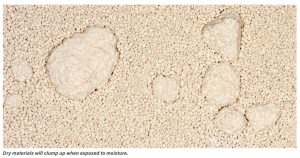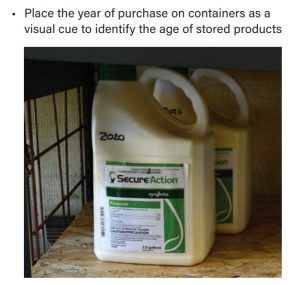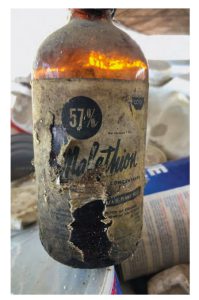
How many of us have lived dangerously by drinking milk past it’s expiration date? Do you ever eat packaged food after it’s “best by” date and does a Twinkie ever expire? Do you know the difference between a “best by” and “expiration” date? Does it matter? What on earth do milk and twinkies have to do with a pesticide blog? Have you ever asked “Are my pesticides still good?” and do you know if your pesticide has a shelf life?
As our most loyal readers well know, the answer for almost everything pesticide related is “refer to and read the pesticide label” but in this instance it might not give you the answers you seek. Although you should always check the label for any information about expiration dates, it might not be there. As a general rule of thumb most manufacturers of pesticides will recommend using a pesticide within 2-3 years of manufacture. However, this can be greatly influenced by storage conditions, product type, unopened vs. opened. For instance, dry materials that are open in a humid environment might clump or otherwise be made unusable. When in doubt contact the phone number found on the pesticide container for guidance.

How Can I Tell?
Many of us are familiar with eating food that is past it’s “best by” date. Perhaps it isn’t quite as tasty as when it was fresh, but it isn’t harmful to eat it. Pesticides can be similar in that they are still effective after that 2-year mark. A company may no longer “guarantee” a product after that, but it does not mean it wouldn’t work. Think of it almost like a warranty, just because your “extended warranty has expired” doesn’t mean your vehicle will break the next day. Always check the pesticide container for printed expiration dates or any language that would prohibit using that product, the label is the law. If there is nothing preventing using a pesticide after the “warranty” period, there are still a few things to consider:
- Inspect the formulation – does it look different than fresh material, has it separated, is there anything wrong with the appearance?
- Remix/shake formulation – shaking liquid products that have been sitting for a while may be necessary to resuspend products.
- Do a test treatment – find a treatment that is low risk should the product fail to work. For instance, testing on a small patch of weeds would have a low risk should the product fail, weeds only grow so fast. Testing a fungicide during an active infestation may NOT be ideal, as by the time you were able to retreat the damage would be irreversible.
If the product looks good, was properly shaken, and worked in the test plot, then you can utilize it for your management operations. Throwing away good product is not ideal, as it wastes that product, can be expensive, and is not how the product is intended to be used.
How Can I Avoid Spoilage?

The best thing to do is NOT find yourself using old/questionable products in the first place. Only buy what you will need and will reliably use within that 2-3 year warranty. Better yet, only buy what you would reliably use within 1 year. Proper storage of pesticides means more than simply keeping a pesticide from getting too hot (a real problem in Florida!) or too cold. That is important, but so is storing pesticides such that the oldest product is always up front, use older stuff first! It is a great idea to write the date of purchase on your pesticide containers so you can more easily manage your supply. Ben Franklin is often credited with the phrase “An ounce of prevention is worth a pound of cure”. Well with pesticides an ounce of planning is worth gallons of product! Yes, planning what you will need, when you will need it, and managing your supply properly can save product and money.
How Can I Dispose?
Even with the best planning, resourceful use of product, and proper storage it is possible you will have pesticide that doesn’t work, or you don’t want to use anymore. What do you do now? There are several options. Pesticides can always be “disposed of” by applying them according to the label in an approved site. This may seem counterintuitive, but if the treatment is legal, and there is a chance the pesticide could still help towards your management goals, this is not a bad idea. This ONLY works IF you still have the label and can follow ALL the rules on that label. What if you no longer have the label, or have no idea what the product is? In that case there are two other options available.

- Many states will have “amnesty days” where they will collect unwanted pesticides, often free of charge. In Florida, this program is call Operation Cleansweep and more information can be found: https://floridadep.gov/waste/permitting-compliance-assistance/content/operation-cleansweep-pesticides
You can also email cleansweep@fdacs.gov or call 877-851-5285
2. Pesticides can be disposed of according to state and local regulations for hazardous waste disposal. Check your local sanitation department for guidance and locations, as well as any possible cost.
For more information about pesticide disposal check out the National Pesticide Information Center. NEVER throw pesticides in the garbage or just dump them out. This is not just a bad idea it is illegal and could be a FEDERAL crime. Nobody wants to pollute or damage the environment and certainly nobody would risk jail when there are other options available right???
More Info
This blog was a VERY short rundown about the shelf-life of pesticides and how to best manage your supply. For a much more detailed and fantastic discussion about pesticide shelf-life refer to Is This Pesticide On My Shelf Still Good? by Dr. Fred Whitford at Purdue University. As an aside, my very first pesticide applicator license came from a training I did with Dr. Whitford, so if you enjoy these blogs thank him…if you don’t, blame me! Joking aside Dr. Whitford has many publications and a very robust focus on pesticide safety and is a tremendous resource to applicators and pesticide safety educators alike! Check out his program here: Dr. Whitford
We started this blog with milk and Twinkies and somehow made that fit with pesticide safety. With proper storage, planning, inventory management, and general awareness you can avoid having to discard pesticides or hold you nose and hope they are still good. So next time you ask “are my pesticides still good?” the answer should be an emphatic YES!
We have created a survey to hear from readers like you, please take a minute or two and give us the feedback we can use to make this blog even better:
Survey
Click To Subscribe
Useful links:
https://edustore.purdue.edu/item.asp?Item_Number=PPP-142
https://blogs.ifas.ufl.edu/pesticideinformation/tag/parts-of-a-pesticide-label/
http://npic.orst.edu/health/disposal.html
 1
1
